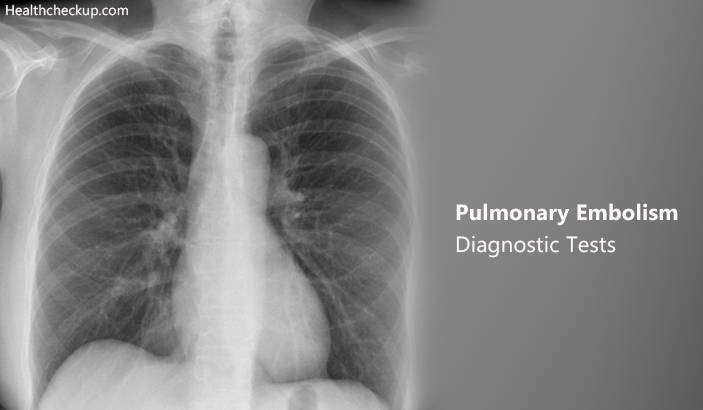A pulmonary embolism is a blockage in the pulmonary artery, which supplies the blood to the lungs. The reason is normally a blood coagulation in the leg considered a profound vein thrombosis that loosens up and ventures out through the circulation system to the lung. Pneumonic embolism is a genuine condition that can cause:
- Permanent damage to the affected lung
- Low oxygen levels in your blood
- Damage to other organs in your body from not getting enough oxygen
If a clot is large, or if there are many clots, pulmonary embolism can cause death. Therefore, pulmonary embolism diagnostic tests are life saver tests and must be conducted at regular intervals.
Preparation For Pulmonary Embolism Diagnostic Tests
The pulmonary embolism diagnostic tests are conducted via blood tests, CT scans, ultrasounds, and MRI testing.
Your specialist will clarify the technique of the test output to you, and also the dangers related to the test. You will be requested to sign an assent shape after the conceivable dangers have been clarified and you’ve had an opportunity to make any inquiries.
Prior to the test, you should enlighten your specialist concerning any known sensitivities you have, especially to differentiate colors or latex. This will ensure your specialist and whatever remains of the therapeutic staff are set up for the likelihood of an unfavourably susceptible response amid the test.
It’s likewise imperative that you tell your specialist in case you’re pregnant or breastfeeding. The difference colour utilized might be passed on to the baby or through the bosom drain.
You ought to illuminate your specialist on the off chance that you’ve had a test that incorporated the utilization of radioactive materials called an atomic test in the previous 48 hours. In the event that you have, there might be radioactive color staying in your body, which can influence the consequences of the test.
You should attempt to wear a baggy dress without a metal clasp to the test, or you might be requested to change into a patient outfit. It’ll additionally be important to expel any metal gems, including piercings, so you may wish to likewise abstain from wearing gems to the test. For the most part, there is no uncommon dietary readiness. For example, fasting before the output.
You may likewise be solicited to have an X-beam from your chest completed 24 to 48 hours before your test.
Pulmonary Embolism Tests Procedure
These are the kinds of blood tests for pneumonic embolism.
D-dimer
Your specialist will arrange a D-dimer blood test to encourage analyze or discount the nearness of a pneumonic embolism. The D-dimer test estimates the levels of a substance that is created in your circulation system when a blood coagulation separates.
In the event that your specialist feels that the likelihood that you have an aspiratory embolism is high based off their clinical evaluation, a D-dimer test probably won’t be performed.
Troponin
In the event that you’ve been determined to have the pneumonic embolism, your specialist may arrange a troponin test to help assess if any damage to your heart has happened. Troponin is a protein that is discharged into your circulatory system when there’s been harm to your heart.
BNP
Like the troponin blood test, your specialist may arrange a BNP blood test on the off chance that you’ve been determined to have an aspiratory embolism. This test is regularly requested to assess the reality of heart disappointment. BNP and related mixes are discharged into the circulation system when the heart is buckling down to pump blood. This can occur in pneumonic embolism because of the blockage of veins.
In order to collect the sample for the D-dimer, troponin, and BNP blood tests, a blood sample will be drawn from a vein in your arm.
Results For Pulmonary Embolism Tests
D-dimer
On the off chance that the aftereffects of the D-dimer blood test fall into the typical or negative range and you don’t have many hazard factors, you likely don’t have a pneumonic embolism. Nonetheless, if the outcomes are high or positive, it demonstrates that there are noteworthy clump arrangement and debasement happening in your body.
A positive D-dimer result doesn’t show where the coagulation is situated in your body. Your specialist should arrange additionally tests to get that data.
Furthermore, there are different elements that can cause your D-dimer result to be high. These include
- Recent Surgery or Trauma
- Heart Attack
- Current or Recent Infection
- Liver Disease
- Pregnancy
Troponin
Large amounts of troponin in your blood, especially in a progression of troponin blood tests performed more than a few hours, shows that there has presumably been some harm to the heart.
Since troponin discharge is particular to damage of your heart muscles, this test can’t distinguish damage to different muscles in your body, for example, skeletal muscles.
- Heart Attack
- Stable or Unstable Angina
- Congestive Heart Failure
- Heart Inflammation
- Kidney Disease
- Current or Recent Infection
- Tachycardia and Tachyarrhythmias
BNP
The level of BNP present in the blood is identified with the seriousness of the heart disappointment, with more elevated amounts showing a poorer viewpoint.
BNP levels can likewise be expanded in the blood because of the accompanying components
- Increased age
- Kidney disease
- Dysfunction of the left or right ventricle of the heart
pulmonary embolism diagnostic tests are very important to maintain the proper well-being of the body. One must be aware of all the factors related to the same.
Medically Reviewed By









